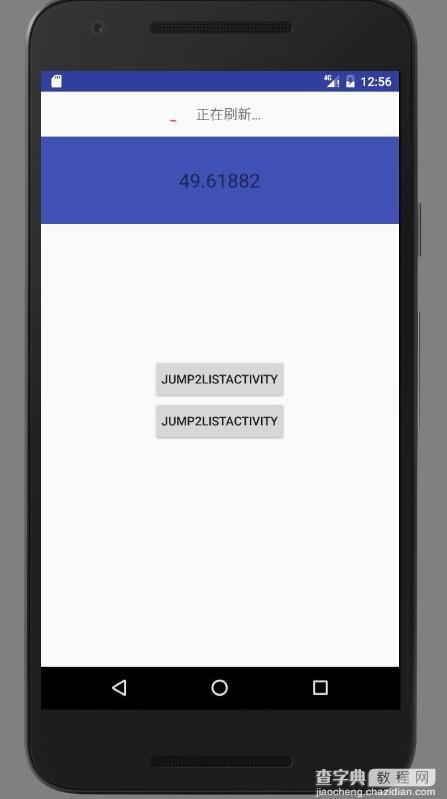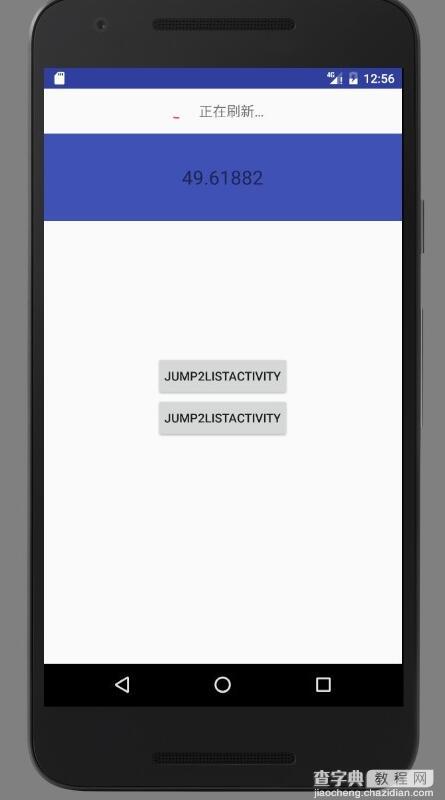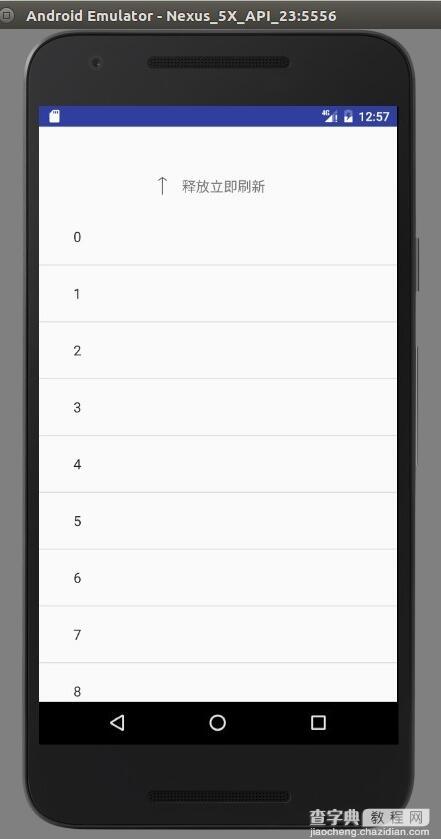这是在了解下拉刷新功能原理下的产物,下拉刷新可以说是国产APP里面必有的功能,连Google都为此出了SwipeRefreshLayout,一种MD风格的下拉刷新。
不过,MD风格在国内似乎很是艰难,不单单是国内系统主流仍是4.4的原因,也有用户习惯的问题,扯的有点多了,在看了许多博客之后,我突然想写一个能仿照 SwipeRefreshLayout 的兼容所有控件的下拉刷新,不单单只是 ListView,希望它也可以包容普通的View和ScrollView,经过两天的奋斗,终于搞定了,因为我的目的只是想要下拉刷新,所以功能很少,不过,如果能把下拉刷新搞定了,其它的功能,就可以慢慢堆砌起来了。
新系统的原因,无法给出合适的gif,只能截图了:
第一张图片展示的是TextView:

第二章图片展示的是ListView:

第三章图片展示的是ScrollView:

基本上这就是我测试的成功的控件,兼容普通的View是最简单的,复杂一点的就是ListView和ScrollView。
思路:我的思路和大部分博客都是一样的,自定义一个ViewGroup,然后将包含的要拖拽的控件的Touch事件交给 RefreshableView 处理,动态改变 headView 的 marginTop 的值,以上。当然,这其中会有一些细节要注意,比如 onTouch 方法的返回值的处理,还有子 View 的 MarginTop 值的处理。
源码
先是headView的布局文件:
<"1.0" encoding="utf-8"?> <LinearLayout xmlns:android="http://schemas.android.com/apk/res/android" android:layout_width="match_parent" android:layout_height="wrap_content" android:gravity="center" android:orientation="horizontal"> <ImageView android:id="@+id/imageView_down" android:layout_width="14dp" android:layout_height="24dp" android:padding="2dp" android:src="@drawable/svg_down" /> <ProgressBar android:visibility="gone" android:id="@+id/progressBar" android:layout_width="20dp" android:layout_height="20dp" android:progressDrawable="@drawable/progressBar" /> <TextView android:padding="15dp" android:id="@+id/textView" android:layout_width="wrap_content" android:layout_height="wrap_content" android:text="@string/pull_to_refresh" android:textSize="16sp" /> </LinearLayout>
接下来就是至关重要的类 RefreshableView:
package com.pull2refresh; import android.animation.ObjectAnimator; import android.animation.ValueAnimator; import android.annotation.TargetApi; import android.content.Context; import android.os.Build; import android.util.AttributeSet; import android.util.Log; import android.view.LayoutInflater; import android.view.MotionEvent; import android.view.View; import android.view.ViewConfiguration; import android.view.ViewGroup; import android.view.animation.RotateAnimation; import android.widget.ImageView; import android.widget.LinearLayout; import android.widget.ProgressBar; import android.widget.TextView; import shike.xianrou.com.pull2refresh.R; /** * Created by cjh on 16-9-6. */ public class RefreshableView extends LinearLayout implements View.OnTouchListener { private static final String TAG = "RefreshableView"; private static final int REFRESHING = 0;//正在刷新 private static final int ORIGINAL = REFRESHING + 1;//初始状态 private static final int RELEASE_TO_REFRESHING = ORIGINAL + 1;//释放即将刷新的状态 private int current_status = ORIGINAL;//当前最新状态 private LinearLayout headView;//刷新layout private TextView textView;//刷新layout中的文字提示 private ImageView imageView;//刷新layout中的箭头 private ProgressBar progressBar;//刷新layout中的进度条 private View view;//手指控制的下拉的View private int hideHeight;//刷新layout要隐藏的高度 private boolean isablePull;//是否可以下拉,例如当 current_status = REFRESHIING 时是不可以下拉拖拽的 private float yDown;//手指按下的坐标 private int touchSlop = ViewConfiguration.get(getContext()).getScaledTouchSlop();//界限值,防止手指误触,过于灵敏 private boolean firstLayout = true;//第一次调用onLayout的时候置为false private int maxMarginTop;//刷新Layout能拉下的最大距离 private MarginLayoutParams marginLayoutParams;//刷新layout的MarginLayoutParams private String pull_to_refresh = "下拉可以刷新"; private String release_to_refresh = "释放立即刷新"; private String refreshing = "正在刷新…"; private int original_margin = 0;//针对下拉的View存在MarginTop这中特殊值的处理 public interface PullToRefreshListener { void onRefresh(); } private PullToRefreshListener pullToRefreshListener; public void addPullToRefreshListener(PullToRefreshListener pullToRefreshListener) { this.pullToRefreshListener = pullToRefreshListener; } public RefreshableView(Context context) { super(context); init(); } public RefreshableView(Context context, AttributeSet attrs) { super(context, attrs); init(); } public RefreshableView(Context context, AttributeSet attrs, int defStyleAttr) { super(context, attrs, defStyleAttr); init(); } @TargetApi(Build.VERSION_CODES.LOLLIPOP) public RefreshableView(Context context, AttributeSet attrs, int defStyleAttr, int defStyleRes) { super(context, attrs, defStyleAttr, defStyleRes); init(); } private void init() { headView = (LinearLayout) LayoutInflater.from(getContext()).inflate(R.layout.refresh_layout, null, true); imageView = (ImageView) headView.findViewById(R.id.imageView_down); progressBar = (ProgressBar) headView.findViewById(R.id.progressBar); textView = (TextView) headView.findViewById(R.id.textView); progressBar.setVisibility(View.GONE); setOrientation(VERTICAL); addView(headView, 0); } @Override protected void onLayout(boolean changed, int l, int t, int r, int b) { super.onLayout(changed, l, t, r, b); Log.d(TAG, "onlayout"); if (changed && firstLayout) { //将View的Touch时间的处理交给RefreshableView去处理 view = getChildAt(1); view.setOnTouchListener(this); //刷新layout的 marginTop 的最大值设为刷新头的高度 maxMarginTop = headView.getHeight(); //要将控件完全隐藏起来,那么隐藏的高度就设置为控件的高度 hideHeight = -headView.getHeight(); marginLayoutParams = (MarginLayoutParams) headView.getLayoutParams(); marginLayoutParams.topMargin = hideHeight; headView.setLayoutParams(marginLayoutParams); //这里必须将firstLayout设置为false,否则在处理Touch是件的过程中,headView在怎么调用setLayoutParams都会被置为初始的隐藏状态 firstLayout = false; //如果子View是一个ViewGroup 那么就需要计算出子View的MarginTop的值,因为如果MarginTop不为0,那么子View的Y轴坐标和父View的坐标是不一样的 if (view instanceof ViewGroup) { int[] childLocations = new int[2]; int[] viewLocations = new int[2]; view.getLocationOnScreen(viewLocations); ((ViewGroup) view).getChildAt(0).getLocationOnScreen(childLocations); original_margin = childLocations[1] - viewLocations[1]; Log.d(TAG, "onLayout viewLocations[1] " + viewLocations[1]); Log.d(TAG, "onLayout locations[1] " + childLocations[1]); Log.d(TAG, "onLayout original_margin " + original_margin); } } } @Override public boolean onTouch(View view, MotionEvent motionEvent) { if (pullToRefreshListener != null) { isAblePull(); if (isablePull) { switch (motionEvent.getAction()) { case MotionEvent.ACTION_DOWN: yDown = motionEvent.getRawY(); break; case MotionEvent.ACTION_MOVE: float yMove = motionEvent.getRawY(); float distance = yMove - yDown; //如果手势是向上的,并且手势在Y轴的移动距离小于界限值,那么就不处理 if (distance < 0 || Math.abs(distance) < touchSlop) return false; //MarginTop的距离是手势距离的1/2,形成费力延迟的效果 marginLayoutParams.topMargin = (int) (distance / 2 + hideHeight); Log.d(TAG, "topMargin " + marginLayoutParams.topMargin); //如果大于最大的MarginTop的值的时候,就将值置为 maxMarginTop if (marginLayoutParams.topMargin >= maxMarginTop) marginLayoutParams.topMargin = maxMarginTop; if (marginLayoutParams.topMargin >= 0) { //当刷新头完全显示的时候,改变状态,置为 释放刷新的状态 if (current_status != RELEASE_TO_REFRESHING) { rotate(0, 180); textView.setText(release_to_refresh); } current_status = RELEASE_TO_REFRESHING; } else { //否则就置为初始状态 if (current_status != ORIGINAL) { rotate(180, 360); textView.setText(pull_to_refresh); } current_status = ORIGINAL; } headView.setLayoutParams(marginLayoutParams); break; case MotionEvent.ACTION_CANCEL: case MotionEvent.ACTION_UP: float yUp = motionEvent.getRawY(); float dis = yUp - yDown; if (dis > 0 && Math.abs(dis) > touchSlop) switch (current_status) { //释放刷新 case RELEASE_TO_REFRESHING: animateMarginTop(marginLayoutParams.topMargin, 0); imageView.clearAnimation(); imageView.setVisibility(View.GONE); progressBar.setVisibility(View.VISIBLE); textView.setText(refreshing); pullToRefreshListener.onRefresh(); break; //初始化 case ORIGINAL: reset(); //从当前的MarginTop的值,转变到隐藏所需的 MarginTop animateMarginTop(marginLayoutParams.topMargin, hideHeight); break; } else return false; break; } return true; } } return false; } /** * 判断是否可以下拉 * * @return */ public boolean isAblePull() { //统一判断,其实主要是对于view是普通View的判断 if (current_status != REFRESHING) isablePull = true; else isablePull = false; if (view instanceof ViewGroup) { isablePull = false; View childView = ((ViewGroup) view).getChildAt(0); int[] viewLocations = new int[2]; int[] childViewLocations = new int[2]; view.getLocationOnScreen(viewLocations); childView.getLocationOnScreen(childViewLocations); //这一步中的 original_margin 至关重要,就是用来兼容 子View 有MarginTop属性的值,当childView 的Y轴坐标 和 计算出了 Margin 值后的父View坐标相等时,说明此时处于可下拉的状态 if (viewLocations[1] + original_margin == childViewLocations[1]) isablePull = true; else isablePull = false; } return isablePull; } private void rotate(int from, int to) { RotateAnimation rotateAnimation = new RotateAnimation(from, to, imageView.getWidth() / 2, imageView.getHeight() / 2); rotateAnimation.setDuration(100); rotateAnimation.setFillAfter(true); imageView.startAnimation(rotateAnimation); } private void animateMarginTop(int from, int to) { ObjectAnimator objectAnimator = ObjectAnimator.ofInt(headView, "cjh", from, to); objectAnimator.setDuration(300); objectAnimator.addUpdateListener(new ValueAnimator.AnimatorUpdateListener() { @Override public void onAnimationUpdate(ValueAnimator valueAnimator) { int margin = (int) valueAnimator.getAnimatedValue(); marginLayoutParams.topMargin = margin; headView.setLayoutParams(marginLayoutParams); } }); objectAnimator.start(); } public void complete() { animateMarginTop(0, hideHeight); reset(); } private void reset() { rotate(180, 360); textView.setText(pull_to_refresh); imageView.setVisibility(View.VISIBLE); progressBar.setVisibility(View.GONE); } }
使用:
<com.pull2refresh.RefreshableView android:id="@+id/refreshableView" android:layout_width="match_parent" android:layout_height="wrap_content" android:gravity="center"> <com.pull2refresh.MTextView android:id="@+id/mTextView" android:layout_width="match_parent" android:layout_height="100dp" android:background="@color/colorPrimary" android:gravity="center" android:text="Hello World!" android:textSize="22sp" /> </com.pull2refresh.RefreshableView>
... refreshableView.addPullToRefreshListener(new RefreshableView.PullToRefreshListener() { @Override public void onRefresh() { setData(); } }); ... private void setData() { ObjectAnimator objectAnimator = ObjectAnimator.ofFloat(textView, "text", 1f, 100f); objectAnimator.setDuration(3000); objectAnimator.addUpdateListener(new ValueAnimator.AnimatorUpdateListener() { @Override public void onAnimationUpdate(ValueAnimator valueAnimator) { textView.setText((Float) valueAnimator.getAnimatedValue()); } }); objectAnimator.addListener(new Animator.AnimatorListener() { @Override public void onAnimationStart(Animator animator) { } @Override public void onAnimationEnd(Animator animator) { refreshableView.complete(); } @Override public void onAnimationCancel(Animator animator) { } @Override public void onAnimationRepeat(Animator animator) { } }); objectAnimator.start(); }
在我自定义的 RefreshableView 中,如果不设置下拉的监听,就没有下拉的效果,也就是不支持下拉
以上就是本文的全部内容,希望对大家的学习有所帮助,也希望大家多多支持查字典教程网。
【Android自定义下拉刷新控件RefreshableView】相关文章:
